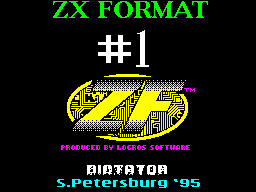|
ZX Format #01
31 октября 1995 |
|
Programmers - Assembler: Assembler for Dummies

Assembler in Pictures
for Dummies "and not only.
Author: Michael Spitsyn.
________________________________
We are starting a series of articles on
assembler for beginners with
to encourage people to study
this language.
In these articles we Tell about
structure of computer graphics,
sound (48 and 128) and, naturally,
about the assembly.
So ...
1.PROTSESSOR COMPUTER
As a person, and every computer has a brain, this brain
the computer is the processor.
And what of the "brain" in our
Speccy?
"Brain" Spectrum - a Z80 processor company ZILOG. Z80 CPU is
псевдошестнадцатиразрядным. What does it mean?
The fact that each processor can understand the numbers
certain discharge. For example eight-number is written as a
combination of eight binary ones and zeros
and may designate any whole
number from 0 to 255.
Each digit of this number,
a power of two, for example
binary number 01100110 corresponds to the decimal 102, and
convert from decimal to binary can be as follows:
2 ^ 7 * 0 +2 ^ 6 * 1 +2 ^ 5 * 1 +2 ^ 4 * 0 +2 ^ 3 * 0 +
2 ^ 2 * 1 +2 ^ 1 * 1 +2 ^ 0 * 0 = 102
Continue. Z80 has twenty
eight-registers (the register of a cell inside the processor,
where you can record the numbers) and all registers are
combined in pairs, each of which have
said: "register pair.
So we got to answer
our question - 8 +8 = 16, so register pair gives
hexadecimal number.
Now why Speccy
not just Hexadecimal,
and "pseudo" is.
So we need to register
In order to perform on them
arithmetic operations, namely addition and subtracting.
Unfortunately our little Speccy not able to divide and
multiply, and so no about any more "scary" activities and can
not speak.
So, Processor can add / subtract as registers,
and register pairs, ie perform arithmetic operations
over eight and hexadecimal numbers, as well as registers
are only eight bits (a
you are not IBM), then the processor
"Псевдошестнадцатиразрядный.
Here is a table of all the registers
their purpose:
The main purpose of the register
A 8-th battery
F a flag register
B 8-th counter
BC 16th count
DE register receiver
HL 16th Battery
Index register IX
IY System Index
I interrupt vector
Register R regeneration
SP top of the stack
PC Program Counter
Note:
8 th - eight-
2.PROSTEYSHIE TEAMS
Now consider the simplest
assembly operations, using
As an example, BASIC, with whom, I hope you are familiar with.
The first thing to do for
study the assembly - is to choose a "shell-assembler"
in which you work.
Can you advise TASM128
if you ZX128 or for ZX48,
ZEUS ASSEMBLER.
So begin:
BASIC ASSEMBLER
10 LET A = 1 LD A, 1
20 STOP RET
The command "LET" is equivalent to
command "LD", if you type
and run it, then register "A"
will be entered one. On command "RET" will exit in
calling program (if the program was launched in BASIC,
then the command "RET" it returns
Management BASIC'u).
In all registers, except for "F" and "PC", you can enter
numbers, such as:
LD A, 1, 1 -> A
LD B, 15, 15 -> B
LD HL, 16384, 16384 -> HL
LD IX, 50000; 50000 -> IX
But usually, the programmer does not
lack of registers, then we have to use your computer's memory,
for example:
BASIC ASSEMBLER
LET A = PEEK 23556 LD A, (23556)
After executing this command
in the "A" will be a number,
recorded in a given memory cell, and given that in this
cell BASIC code stores the last key pressed, this command is
not devoid of practical sense.
Also used reverse
Team:
BASIC ASSEMBLER
POKE 23607, A LD (23607), A
But often have to write / read the value of the cell,
address of which calculated
or taken from the table. In this
If we use the following
Team:
Write read
LD (BC), A LD A, (BC)
LD (DE), A LD A, (DE)
LD (HL), 0 LD E, (HL)
Note: I would like to see
that non-existent commands the direct recording of the cell
parameter cards, an as recording from a cell in a cell.
And now I want to lead a program that prints any
message (it is analogous to the operator to "PRINT").
The program uses the command "CALL", to invoke a procedure
ROM, this command can be compared with the BASIC command
"GO SUB", for example:
BASIC ASSEMBLER
10 GO SUB 999 CALL M1
.... ....
999 LET A = 1 M1 LD A, 1
1000 RETURN RET
Here, "M1" is a label, instead of
which in assembly
program will be delivered the appropriate address.
EXAMPLE PROGRAM
After the semicolon in the assembly, as well as after REM
in BASIC written comments.
; Program print text
; Messages. -= PRINT TEXT =
ORG 30000
ENT
START LD A, 1, 1 Open
CALL # 1601; Feed
; Print.
LD DE, TEXT; Address Text
LD BC, LEN; Text Length
CALL # 203C; Print Text
RET
TEXT DEFB 22; code "AT"
DEFB Y, X; Position Print
DEFM "HELLO, EVEREBODY!"
LEN EQU 20; LEN = 20
Y EQU 10; Y = 10
X EQU 5; X = 5
This program is similar to
line BASIC'a:
1910 PRINT AT 10,5; "HELLO,
EVEREBODY! "
In the next issue I will discuss
of arithmetic instructions and commands, comparison, and an
example of a small game.
Bye!
________________________________
Other articles:
Similar articles:
В этот день... 13 December